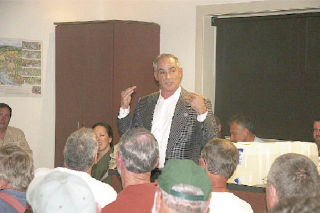Concerned anglers and community members spoke up to oppose the possible closure of the Tokul Creek Fish Hatchery at a packed meeting held last Thursday, Sept. 11 in Issaquah.
The Washington Department of Fish and Wildlife is considering closing the century-old facility, which releases about 190,000 steelhead trout into the Snoqualmie River every year. Under the proposed changes, steelhead production would be cut by about 40,000, and the remaining fish would be produced elsewhere and released into the Skyhomish River system. All or part of the Snoqualmie watershed could be designated as a wild steelhead management zone.
The agency’s goals, said Annette Hoffman, regional fish program manager, are to “restore and maintain abundant, diverse, well-distributed wild steelhead populations.” There’s also a need to trim agency costs.
Some anglers, including Stan Stanforgh, are worried that removing the hatchery fish from the Snoqualmie River will effectively end fishing in the system.
“We don’t see any wild fish. They’re all hatchery fish. Take them away, there’s no fish in the river, no fishing,” he said.
Sound science?
Early in the meeting, Fifth District State Representative Glenn Anderson received loud applause after questioning the “conflicting science and opinions of that science” on whether hatchery steelhead are detrimental to wild fish.
His concerns were echoed by anglers in attendance.
“We haven’t done the scientific research, and we can’t make a decision on the educated guess,” said Andrew Moravec, a Snoqualmie sport fisherman. He said solid facts about the Snoqualmie River system are hard to come by.
“The public hasn’t gotten information in a format that’s easy to understand and find,” he said, calling for a more open planning process.
Hoffman said there was enough scientific evidence to support the changes.
“We have quite a few years of work. We look at the science we have, and it gives us an indication of risks” to wild steelhead, she said. “They’re not risks we can ignore.”
Economic concerns
The abundance of hatchery fish in the Snoqualmie River lures anglers to the area, providing a financial boost to the Valley. Anderson said that stopping production at Tokul Creek would take prosperity away from an already-underserved rural area.
“People invest around the hatchery,” he said.
Moravec, who works in a tackle shop, agreed.
“This is a huge magnitude. People come from all over to spend money on food, gas,


